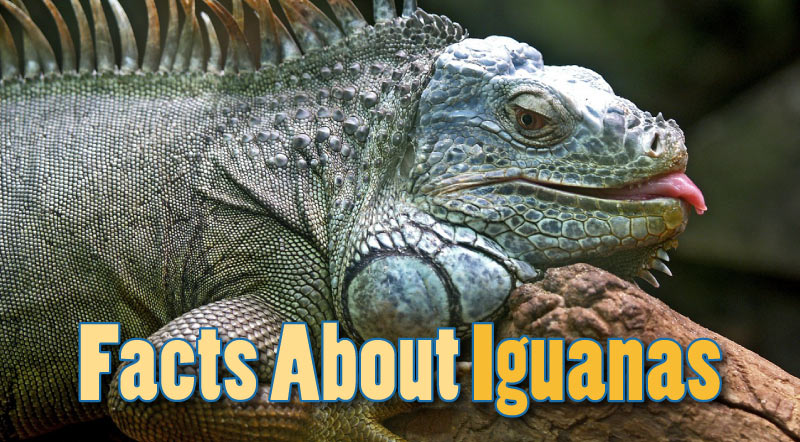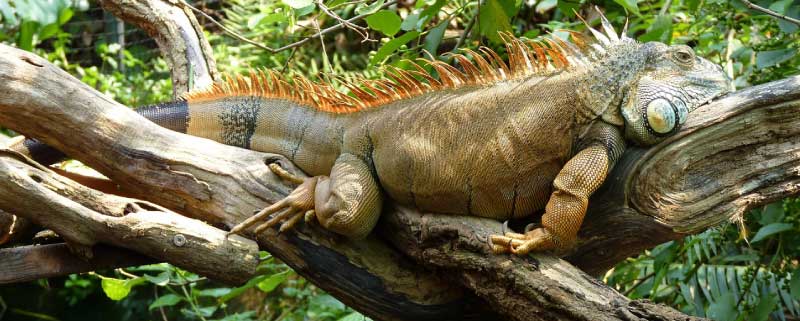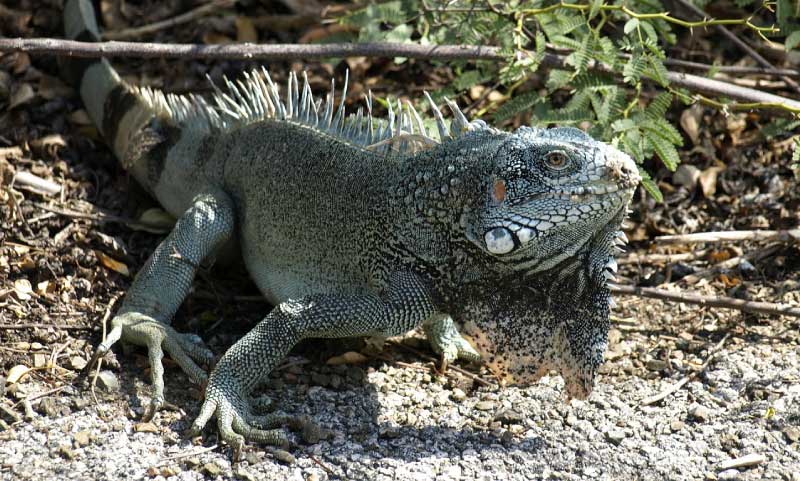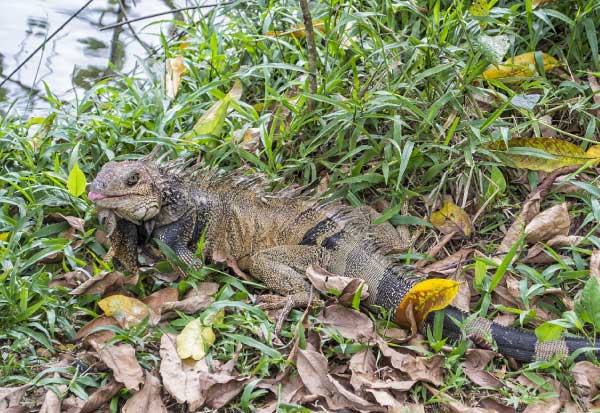Iguanas are large lizards that live in the forests of Central and South America. They have sharp teeth and long, powerful tails, but despite their fearsome looks are mainly herbivorous (plant-eating). Lets learn more facts about iguanas.
Iguana Facts
This article is part of the Active Wild Rainforest Animal series.
Iguanas, despite being large and heavy-looking, are fast and agile. Their tails make up over half their length, and can be used as a defence against predators.
Iguanas have extremely good eyesight, and can even see ultraviolet wavelengths.
Iguanas spend most of their lives in trees, and have a number of special adaptations that help them live in this environment. One of these adaptations is a third eye, which we'll learn more about further down the page!
Types Of Iguanas
There are two main types of iguana, and several other closely-related species that also have 'iguana' in their names.
The two main types of iguana are the green iguana, and the Lesser Antillean iguana.
Green Iguana
The green iguana is usually just called an 'iguana'. When people are talking about iguanas, they are usually referring to green iguanas. Unless specified, this is the type of iguana we'll be talking about in this article.
Green iguanas live in Central and South America and on Caribbean islands. They are also kept as pets.
Green iguanas have a large, round scale on the sides of their faces. This is known as a subtympanic shield.
Lesser Antillean iguana
The other main type of iguana is the Lesser Antillean iguana.
Lesser Antillean iguanas are found on the Lesser Antilles Islands. They are an endangered species, due to habitat loss, hunting, and also to competition with green iguanas.
Lesser Antillean iguanas have shorter faces than green iguanas and do not have stripes on their tails. They also lack the big scale on the side of the head that is present in green iguanas. Lesser Antillean iguanas tend to be various shades of grey in colour, with paler scales around their heads.
How Big Are Iguanas?
Iguanas can grow to between 1.5 and 2 metres in length. They weigh around 4 - 8 kg.
What Do Iguanas Look Like?
Despite their name, green iguanas vary in colour, from pink to black, often depending on where they come from. Their colour allows them to blend in to their environment, protecting them from predation.
Iguanas have a row of spines running down their backs to their tails. Their tails are striped.
The iguanas in the video below were spotted in Florida.
Iguanas Have Three Eyes!
Iguanas have a special third eye on the top of their heads. This eye, called a parietal eye, doesn't see images like normal eyes, instead, it senses lightness / darkness, and movement. Iguanas use this third eye to detect predators.
What do iguanas eat?
Iguanas are herbivores (plant eaters) and eat grasses, leaves, flowers and fruit.
Iguana Habitat
Iguanas live in the canopy layer of the rainforest. They spend much of their lives in the trees. Iguanas tend to live near water, and are excellent swimmers.
Iguana Threats & Defensive Tactics
Iguanas have sharp teeth, spines on their backs, and powerful tails, all of which can be used against attackers.
Like many other lizards, iguanas can shed their tails. They do this if they are being attacked by a predator. The tail comes off in the predator's mouth, allowing the iguana to make its escape. The tail usually grows back, although not often as long as it used to be.
Another defensive tactic used by iguanas in the trees is simply to jump into water and swim to safety.
Top 10 Facts About Iguanas
- Iguanas live in tropical rainforests in Central and South America, and on Caribbean islands.
- Iguanas have extremely good eyesight, and can even see ultraviolet wavelengths.
- Iguanas can fall large distances (up to 15 feet) without hurting themselves. Useful when you spend most of your life up a tree!
- The tail of an iguana is very powerful and can be used as a weapon. Iguanas also have sharp teeth and a strong jaws.
- Iguanas can shed their tails to escape predators.
- Iguanas' main predators are birds of prey.
- In the wild, iguanas can live for 20 years.
- Iguanas are cold blooded, which is why they have to bask in the sun to warm their bodies to the correct temperature.
- Iguanas are very good swimmers, and often live near water.
- Iguanas can breath in lots of air to help them to float in the water.
Discover More with Active Wild
You can discover more amazing rainforest animals on this page: Rainforest Animals List with Pictures & Facts





